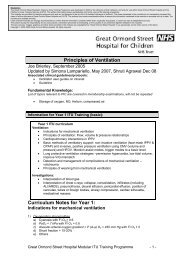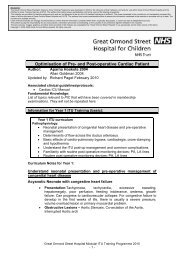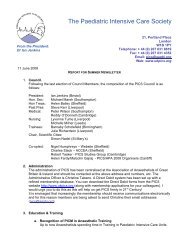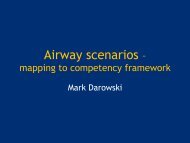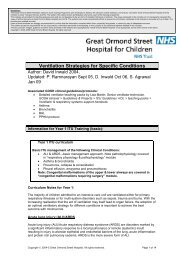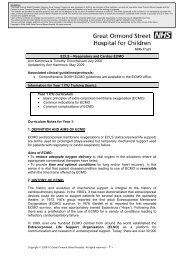Renal Replacement Therapy & Plasmapheresis Quen Mok ... - PICS
Renal Replacement Therapy & Plasmapheresis Quen Mok ... - PICS
Renal Replacement Therapy & Plasmapheresis Quen Mok ... - PICS
You also want an ePaper? Increase the reach of your titles
YUMPU automatically turns print PDFs into web optimized ePapers that Google loves.
Disclaimer:<br />
The Great Ormond Street Great Paediatric Ormond Intensive Street Care Hospital Training Programme Modular ITU was developed Training in Programme 2004 by the clinicians 2008-2009 of that Institution, primarily for use within Great Ormond Street Hospital and the<br />
Children’s Acute Transport Service (CATS). The written information (known as Modules) only forms a part of the training programme.<br />
The modules are provided for teaching purposes only and are not designed to be any form of standard reference or textbook. The views expressed in the modules do not necessarily represent the<br />
views of all the clinicians at Great Ormond Street Hospital and CATS. The authors have made considerable efforts to ensure the information contained in the modules is accurate and up to date. The<br />
modules are updated annually.<br />
Users of these modules are strongly recommended to confirm that the information contained within them, especially drug doses, is correct by way of independent sources.<br />
The authors accept no responsibility for any inaccuracies, information perceived as misleading, or the success of any treatment regimen detailed in the modules.<br />
The text, pictures, images, graphics and other items provided in the modules are copyrighted by “Great Ormond Street Hospital” or as appropriate, by the other owners of the items.<br />
Copyright © 2004-2005 Great Ormond Street Hospital. All rights reserved.<br />
<strong>Renal</strong> <strong>Replacement</strong> <strong>Therapy</strong> & <strong>Plasmapheresis</strong><br />
<strong>Quen</strong> <strong>Mok</strong>, July 2006<br />
Updated: St Mary’s Hospital March 2007 –Claudine de Munter<br />
Associated clinical guidelines/protocols:<br />
• Guidelines for PD<br />
• Guidelines for CVVH<br />
• Plasmafiltration trial protocol<br />
• Trial protocol for Early CVVH in ARDS post BMT<br />
Fundamental Knowledge:<br />
List of topics relevant to PIC that will have been covered in membership examinations.<br />
They will not be repeated here.<br />
• Osmolarity, osmolality, diffusion of molecules across membranes<br />
• Anatomy of abdominal wall (including the inguinal region) Landmarks for suprapubic<br />
and peritoneal lavage catheters<br />
Information for Year 1 ITU Training (basic):<br />
Year 1 ITU curriculum<br />
Peritoneal dialysis:<br />
• Indications, contra indications and complications (including respiratory<br />
complications)<br />
• Understand the effect of dwell time and type of dialysate on the clearance of<br />
molecules.<br />
• Insertion of PD catheter.<br />
Continuous veno-venous haemofiltration:<br />
• Indications, contra indications and complications (hypotension, drug level<br />
interference, bleeding)<br />
• Vascular access requirements<br />
• Basic principles of fluid and electrolyte control<br />
Curriculum Notes for Year 1:<br />
General Indications for renal replacement therapy (RRT)<br />
• <strong>Renal</strong> failure<br />
• Fluid overload<br />
• Severe electrolyte imbalance<br />
• Manipulation of metabolic environment<br />
• Tumour lysis syndrome<br />
• Drug intoxication<br />
• Rhabdomyolysis<br />
• ?Inflammatory mediator removal in sepsis<br />
Copyright © 2008-9 Great Ormond Street Hospital. All rights reserved. - 1 -
Great Ormond Street Hospital Modular ITU Training Programme 2008-2009<br />
The specific therapy used depends on available expertise in the unit, the child’s size and<br />
clinical condition. Also studies show that early dialysis leads to a better outcome with a lower<br />
mortality and a shorter length of stay than starting dialysis late [1]<br />
Transport mechanisms and solute clearance<br />
Dialysis – small molecules easily removed by diffusion<br />
Haemofiltration – as fluid is removed, the solute is cleared by convection (solvent drag).<br />
Solute clearance is therefore dependent on sieving coefficient of solute and ultrafiltrate<br />
removal, which is dependent on the hydrostatic pressure gradient either side of the<br />
membrane. This will depend on blood flow, filter surface area and ultrafiltration rate (%<br />
filtration fraction). Hence middle sized and small molecules can be removed.<br />
Osmosis – movement of water from a higher to lower water concentration<br />
Peritoneal dialysis<br />
Removal of solutes is by diffusion due to an osmotic pressure gradient across the semipermeable<br />
peritoneal membrane. Removal of fluid is achieved with the use of dialysate<br />
solutions containing hypertonic glucose or other osmotically active particles (see figure 2-10<br />
below).<br />
Generally use 10-20 ml/kg volumes with ½ - 1 hour cycles.<br />
Increased clearance by<br />
• Increased dwell time, to a degree<br />
• Increased dialysis volume<br />
• Increased osmolality of dialysis solution<br />
(see figures below)<br />
Copyright © 2008-9 Great Ormond Street Hospital. All rights reserved. - 2 -
Great Ormond Street Hospital Modular ITU Training Programme 2008-2009<br />
Copyright © 2008-9 Great Ormond Street Hospital. All rights reserved. - 3 -
Great Ormond Street Hospital Modular ITU Training Programme 2008-2009<br />
Indications – child
Great Ormond Street Hospital Modular ITU Training Programme 2008-2009<br />
<strong>Replacement</strong> solution<br />
Fluid and solutes removed must be replaced by replacement fluid to maintain fluid<br />
homeostasis. This replacement can be done pre- or post-filter. We tend to replace our<br />
solutions pre-filter as it results in increased effective filter life.<br />
We prefer to use potassium free replacement solutions so that we can add the desired<br />
amount of potassium as required, although there are commercially available solutions<br />
containing different concentrations of potassium.<br />
Lactate based<br />
• Monosol (30mmol/l lactate)<br />
• Haemofiltrasol (45 mmol/l lactate)<br />
Lactate free – needs bicarbonate as buffer, which is added at time of use. In the newer<br />
solutions a standard amount may already be provided in a separate compartment<br />
• Accusol<br />
• Edwards Bicaflac<br />
• Hospal Hemasol<br />
• Normocarb<br />
• Baxter LF10<br />
Lactate free solutions are ideal for patients with liver dysfunction and for neonates where the<br />
immature liver is unable to convert lactate to bicarbonate. We would also use lactate free<br />
solutions for patients with significant acidosis or inborn errors of metabolism. Different<br />
solutions have different concentrations of sodium depending on how much sodium<br />
bicarbonate is added.<br />
Anticoagulation<br />
The requirement for anticoagulation depends on the condition of the haemostatic system,<br />
which in critically ill acute renal failure patients may show a reduced procoagulant potential,<br />
an activated coagulation or a combination of both [3]. Anticoagulation of the circuit can be<br />
with heparin (standard or low molecular weight), prostacyclin or citrate. No anticoagulant may<br />
be required if the patient is already coagulopathic. However if the filter clots frequently,<br />
consider regional anticoagulation of the filter using LMW heparin or citrate.<br />
• Standard unfractionated heparin – catalyses inactivation of thrombin, fXa and fIXa by<br />
antithrombin. Generally used and monitored with ACT at the bedside, keeping ACT<br />
between 180-200. Regular lab APTR may be necessary.<br />
• LMW heparin (dalteparin) - adequate anticoagulation monitored using anti-Factor Xa<br />
levels. This is done daily and will need to be arranged with the coagulation lab.<br />
• Prostacyclin at 5ng/kg/min to reduce platelet aggregation. Heparin sparing effect but<br />
very expensive and affects on BP can be difficult to control in haemodynamically<br />
unstable patients.<br />
• Citrate – causes chelation of calcium, thus depleting necessary co-factor for several<br />
steps in coagulation cascade. Anticoagulation restricted to extracorporeal circuit as<br />
citrate is metabolized to bicarbonate in the liver. Many USA centers are using citrate,<br />
but most of the replacement solutions in the UK contain calcium and this will bind with<br />
citrate and precipitate. If using citrate then this needs to be infused separately from<br />
the replacement solution which will need to be infused post filter. Monitor ionized<br />
calcium levels in the patient and in the circuit. Problem of metabolic alkalosis and<br />
citrate toxicity with ionized hypocalcemia, and high anion-gap metabolic acidosis.<br />
Almost as expensive as prostacyclin.<br />
Complications of CVVH<br />
• Bleeding<br />
• Excessive fluid removal from loss of autoregulation<br />
Copyright © 2008-9 Great Ormond Street Hospital. All rights reserved. - 5 -
Great Ormond Street Hospital Modular ITU Training Programme 2008-2009<br />
• Clearance of drugs especially if low protein binding<br />
• Hypotension from excessive fluid loss or clearance of inotropes<br />
• Malnutrition from clearance of many amino acids – this may be reduced if nutrition is<br />
optimized during RRT.<br />
Other sources of information:<br />
Websites:<br />
Peds CRRT website www.pcrrt.com<br />
Acute Dialysis Quality Initiative group website www.ADQI.net<br />
References:<br />
1. Quan A and Quigley R. <strong>Renal</strong> replacement therapy and acute renal failure. Curr Opin<br />
Pediatr 2005; 17:205-9<br />
2. Kellum JA, Angus DC, Johnson JP et al. Continuous versus intermittent renal<br />
replacement therapy: a meta-analysis. Intensive Care Med 2002; 28: 29-37<br />
3. Schetz M. Anticoagulation for continuous renal replacement therapy Curr Opin<br />
Anaeathesiol 2001; 14:143-9<br />
Information for Year 2 ITU Training (advanced):<br />
Year 2 ITU curriculum<br />
Continuous veno-venous haemofiltration:<br />
Complete understanding of<br />
• Indications, contra indications and complications<br />
• Principles of fluid and electrolyte control: flow rate, % filtration fraction and fluid<br />
balance.<br />
<strong>Plasmapheresis</strong>:<br />
• Indications, contraindications and complications<br />
• Need to replace immunoglobulin<br />
Haemodialysis:<br />
• Indications, contra indications and complications<br />
• Haemodynamic effects.<br />
Curriculum Notes for Year 2:<br />
CVVH<br />
Increased solute clearance by<br />
• Bigger filters with larger membrane surface area<br />
• Increased blood flow rate Qb through filter<br />
• Increased ultrafiltration rate Qf<br />
• Addition of countercurrent dialysis (CVVHD), to a certain extent<br />
The comparison of CVVH with CVVHD or CVVHDF (CVVH with countercurrent dialysate flow<br />
or continuous veno-venous haemodiafiltration) shows that all are equally effective [4,5]. We<br />
tend to use CVVH in PICU as we have managed effective solute clearance with large filters<br />
and by adjusting blood flows and filtration fractions. Higher ultrafiltration rates (35 or 45<br />
ml/kg/h compared to 20 ml/kg/h) improved survival significantly [6]. Early institution of RRT<br />
Copyright © 2008-9 Great Ormond Street Hospital. All rights reserved. - 6 -
Great Ormond Street Hospital Modular ITU Training Programme 2008-2009<br />
before >10% excess volume overload and before the BUN is higher than 80 mg/dl is<br />
associated with better outcome and survival [5,7,8]<br />
To increase potential clearance of inflammatory mediators from blood by CVVH various<br />
modifications to the technique have been attempted. This includes high volume HF [9],<br />
haemodiafiltration, high flux filters [10], frequent membrane changes to allow for adsorptive<br />
removal [11], high permeability membranes [12], and plasmafiltration (see below). At present<br />
there is a lack of randomised trials and the available studies show an absence of benefit.<br />
Haemodialysis (HD)<br />
This is an extracorporeal therapy where toxins and fluid are removed by diffusion across an<br />
artificial semi-permeable membrane of the dialyzer into the dialysate fluid. HD is performed by<br />
the dialysis team from the renal unit, and a treatment cycle is usually done over 3-4 h, and on<br />
alternate days. There is evidence that daily HD results in improved control of uraemia and BP,<br />
a more rapid resolution of ARF and a lower mortality compared to alternate day HD [3]<br />
Indications – rapid removal of small molecules e.g. severe hyperkalaemia >7mmol/l or<br />
massive tumour lysis. However in our unit CVVH may be more readily available out of hours.<br />
Contraindications – cardiovascular instability due to rapid fluid removal<br />
Complications<br />
• Haemodynamic instability<br />
• Disequilibrium syndrome due to rapid solute clearance and large fluid shifts especially<br />
across cell membranes leading to raised ICP and seizures<br />
• Anaphylactoid reactions (chest pain, dyspnoea, hypotension) from bioincompatible<br />
dialysis membrane (cuprophane cellulose)<br />
<strong>Plasmapheresis</strong><br />
Plasma exchange – plasma is removed and replaced by donor plasma<br />
<strong>Plasmapheresis</strong> – plasma is removed and replaced with fluid other than plasma, usually<br />
albumin<br />
Can be done by centrifugation or by filtration (plasmafiltration).<br />
Can be done by renal team or ICU team, and in most cases the “course” of therapy consists<br />
of 4-5 cycles.<br />
Indications<br />
Large molecules including proteins, inflammatory mediators and bacteria are removed nonselectively,<br />
thus this is theoretically a useful technique in vasculitides and septic shock.<br />
Immune mediated – acceptable “standard” therapy<br />
• Severe acute polyneuropathy (Guillain-Barre)<br />
• Myasthenia gravis<br />
• Goodpasture’s and other vasculitides<br />
• TTP<br />
• HUS<br />
• Acute poisoning or overdose with certain drugs<br />
Many other conditions where conventional therapy is tried first as inadequate evidence<br />
available of its efficacy in randomized trials<br />
• SLE<br />
• Dermatomyositis<br />
• Juvenile idiopathic arthritis<br />
• Autoimmune haemolytic anaemia<br />
• Sepsis<br />
A randomized study has shown no benefit on mortality in adults with septic shock [13], while<br />
two others showed a tendency to improved outcome [14,15]. There was a trend towards<br />
improvement in children in the Australian study [13] and there is therefore an ongoing trial of<br />
Copyright © 2008-9 Great Ormond Street Hospital. All rights reserved. - 7 -
Great Ormond Street Hospital Modular ITU Training Programme 2008-2009<br />
plasmafiltration in children with septic shock. It is unclear if the beneficial effect of plasma<br />
therapies is due to the removal of inflammatory mediators or to the replacement with fresh<br />
frozen plasma of immunoglobulins and coagulation factors and inhibitors<br />
Complications<br />
• Allergic reaction to bioincompatible membrane<br />
• Concomitant removal of albumin, immunoglobulins and clotting factors<br />
• Bleeding<br />
• Fluid or electrolyte imbalance<br />
Other sources of information:<br />
Websites.<br />
Peds CRRT website www.pcrrt.com<br />
Acute Dialysis Quality Initiative group website www.ADQI.net<br />
References.<br />
1. Quan A and Quigley R. <strong>Renal</strong> replacement therapy and acute renal failure. Curr Opin<br />
Pediatr 2005; 17:205-9<br />
2. Kellum JA, Angus DC, Johnson JP et al. Continuous versus intermittent renal<br />
replacement therapy: a meta-analysis. Intensive Care Med 2002; 28: 29-37<br />
3. Schiffl H, Lang SM, Fischer R. Daily hemodialysis and the outcome of acute renal<br />
failure N Engl J Med 2002; 346: 305-10<br />
4. Smoyer WE, Maxvold NJ, Remenapp R, Bunchman TE. <strong>Renal</strong> replacement therapy.<br />
In: Pediatric Critical Care. Second Edition. Farhman BP, Zimmerman JJ (Eds). St.<br />
Louis, MO: Mosby, 1998.<br />
5. Bunchman TE, McBryde KD, Mottes TE, et al. Pediatric acute renal failure: outcome<br />
by modality and disease. Pediatr Nephrol 2001; 16:1067.<br />
6. Ronco C, Bellomo R, Homel P, et al. Effects of different doses in continuous venovenous<br />
haemofiltration on outcomes of acute renal failure: a prospective randomized<br />
trial. Lancet 2000; 356:26-30.<br />
7. Goldstein FL, Currier H, Graf CD, et al. Outcome in children receiving continuous<br />
venovenous hemofiltration. Pediatrics 2001; 107:107:1309.<br />
8. Foland JA, Fortenberry JD, Warshaw BL, et al. Fluid overload before continuous<br />
hemofiltration and survival in critically ill children: a retrospective analysis. Crit Care<br />
Med 2004; 32:1771.<br />
9. Cole L, Bellomo R, Journois D et al. High volume haemofiltration in human septic<br />
shock. Intensive Care Med 2001; 27: 978-86<br />
10. Uchino S, Bellomo R, Goldsmith D et al. Super high flux hemofiltration: a new<br />
technique for cytokine removal. Intensive Care Med 2002; 28: 651-5<br />
11. Cole L, Bellomo R, Hart G, et al. A phase II randomised controlled trial of continuous<br />
hemofiltration in sepsis. Crit Care Med 2002; 30: 100-106<br />
12. Morgera S, Rocktaschel J Haase M et al. Intermittent high permeability hemofiltration<br />
in septic patients with acute renal failure. Intensive Care Med 2003; 29: 1989-95<br />
Copyright © 2008-9 Great Ormond Street Hospital. All rights reserved. - 8 -
Great Ormond Street Hospital Modular ITU Training Programme 2008-2009<br />
13. Reeves JH, Butt WW, Shann F et al. Continuous plasma filtration in sepsis syndrome.<br />
Crit Care Med 1999; 27: 2096-104<br />
14. Schmidt J, Mann S, Mohr VD et al. <strong>Plasmapheresis</strong> combined with continuous<br />
venovenous hemofiltration in surgical patients with sepsis. Intensive Care Med 2000;<br />
26: 532-7<br />
15. Busund R, Koukline V, Utrobin U, Nedashkovsky E. <strong>Plasmapheresis</strong> in severe sepsis<br />
and septic shock: a prospective, randomised, controlled trial. Intensive Care Med<br />
2002; 28: 1434-9<br />
Copyright © 2008-9 Great Ormond Street Hospital. All rights reserved. - 9 -



